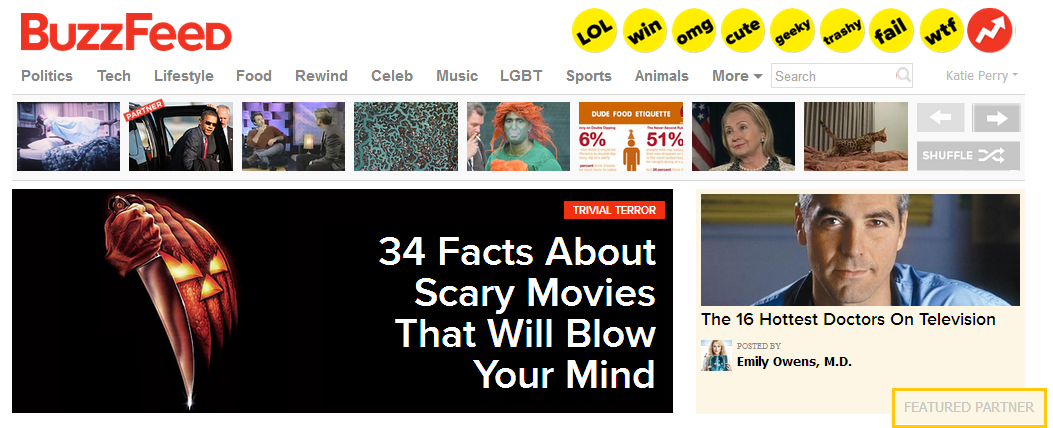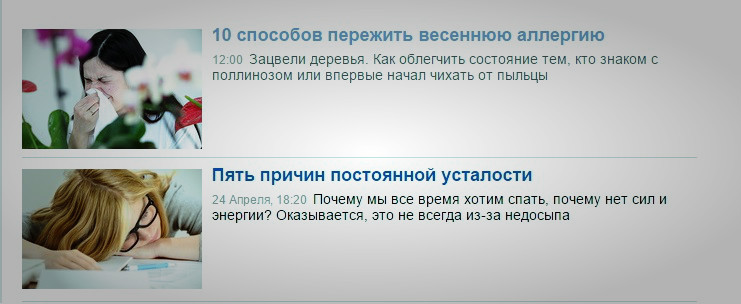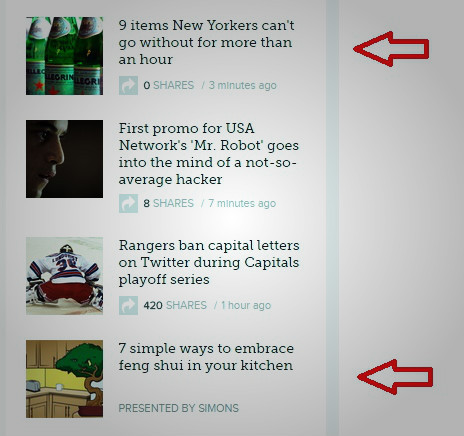“Content is dead. Long live the content! ”Or a little about the BuzzFeed format
John Peretti, when he conceived a small, modest Internet lab called BuzzFeed , perhaps he himself did not guess that his product would revolutionize not only content marketing, but network journalism in general in the future.

The BuzzFeed format is a material that begins with a number, is a list, contains more pictures than text. Not all at once, of course, but some of these elements should be. Such materials are usually small and are often used as bookmarks. The content can be anything - the main thing is not this, the main thing is its form. Take a look at several sites:
')
BuzzFeed itself:

Habr:

Adme:

TVNZ:

Lifehacker:

Look At Me:

Megamind:

Sports.ru:

Men's Cult:

Mashable:

Today, the BuzzFeed format is turning into a standard. It may seem that this time has come a long time ago and has already managed to pass, but in fact it does not. Article lists were popular before BuzzFeed, but it was this media portal, and in particular its popularity, that brought them to a new level. Level when this format is considered standard.
The BuzzFeed format has been mercilessly criticized by the masters of journalism. In particular, at the Faculty of Media Communications at the HSE, this format is presented as “how not to write”. Imagine the surprise of a student who, outside the faculty, sees that almost the entire Internet writes as it would seem “not necessary.”
It is curious that the portal itself uses the format only for articles in headings about life, society, lol, and so on. In the section of serious news and analytical materials of BuzzFeed News articles of this format, if they are found, then only as a photo gallery. Initially, it was created exclusively for photos, but in 2008-2009 it began to be used for other content.
Pros:
Minuses:
There is a great risk of succumbing to temptation and starting to stamp articles into one pattern:
The BuzzFeed format rarely contains analytics or research, the results of which completely new, unknown information is presented to the audience. As a rule, these are facts that are already known to a narrow or wide circle of people, as well as information from different sources, collected in one material. Some mini digest.
There is a risk to chase afterclasses , and stop writing research, case studies and analytics, build charts and graphs, giving all the time to articles of this format. As a result, the genre diversity of the blog disappears.
Many publications and companies misinterpret the meaning of the format and begin to collect well-known facts in the lists. For example, "7 secrets of successful people": get up early, bring things to the end, do not leave for tomorrow what you can do today, continuously improve yourself, firmly go to the goal, do not succumb to difficulties, believe in yourself. Motivating picture and post ready.
Good or bad, BuzzFeed is becoming the standard. “The king is dead. Long live the king! ”French peasants shouted in the 15th century. In fact, according to the laws of the monarchy of those years, after the death of the king, his successor was immediately declared to be such. The BuzzFeed format is this very successor.
Ps Personally, we somehow fell into the trap and began to stamp articles "5 ways to increase conversion", "7 habits of successful people", "10 secrets of success", "8 ways to improve communication with the visitor", "15 sites for web analytics" , “32 free photo stocks”, “22 conversion growth tools” and so on. Today we abandoned this, blog traffic has dropped, but we hope to restore positions with other content. Whether we were mistaken or not, time will show.
Thanks for reading us!
Subscribe to our blog .
Do not forget to visit our site .

The BuzzFeed format is a material that begins with a number, is a list, contains more pictures than text. Not all at once, of course, but some of these elements should be. Such materials are usually small and are often used as bookmarks. The content can be anything - the main thing is not this, the main thing is its form. Take a look at several sites:
')
BuzzFeed itself:

Habr:

Adme:

TVNZ:

Lifehacker:

Look At Me:

Megamind:

Sports.ru:

Men's Cult:

Mashable:

Today, the BuzzFeed format is turning into a standard. It may seem that this time has come a long time ago and has already managed to pass, but in fact it does not. Article lists were popular before BuzzFeed, but it was this media portal, and in particular its popularity, that brought them to a new level. Level when this format is considered standard.
The BuzzFeed format has been mercilessly criticized by the masters of journalism. In particular, at the Faculty of Media Communications at the HSE, this format is presented as “how not to write”. Imagine the surprise of a student who, outside the faculty, sees that almost the entire Internet writes as it would seem “not necessary.”
It is curious that the portal itself uses the format only for articles in headings about life, society, lol, and so on. In the section of serious news and analytical materials of BuzzFeed News articles of this format, if they are found, then only as a photo gallery. Initially, it was created exclusively for photos, but in 2008-2009 it began to be used for other content.
Pros:
- It is convenient to write articles of this format - it is a kind of container of useful (and not very) information, enclosed in a convenient and simple form;
- For the same reason it is convenient to read them. They are easier and better perceived than kilometer texts, overflowing with part-time turnovers;
- They are most often stored in bookmarks as notes, to which you can always return;
- They like, click and shuffle more often;
- In terms of the "time spent - the result" is the best option.
Minuses:
There is a great risk of succumbing to temptation and starting to stamp articles into one pattern:
- Gather useful information on a specific topic.
- Break into 10 pieces
- To number
- Put a funny picture
- To name "10 ways / habits / steps / tips"
- ?????
- PROFIT!
The BuzzFeed format rarely contains analytics or research, the results of which completely new, unknown information is presented to the audience. As a rule, these are facts that are already known to a narrow or wide circle of people, as well as information from different sources, collected in one material. Some mini digest.
There is a risk to chase after
Many publications and companies misinterpret the meaning of the format and begin to collect well-known facts in the lists. For example, "7 secrets of successful people": get up early, bring things to the end, do not leave for tomorrow what you can do today, continuously improve yourself, firmly go to the goal, do not succumb to difficulties, believe in yourself. Motivating picture and post ready.
Conclusion
Good or bad, BuzzFeed is becoming the standard. “The king is dead. Long live the king! ”French peasants shouted in the 15th century. In fact, according to the laws of the monarchy of those years, after the death of the king, his successor was immediately declared to be such. The BuzzFeed format is this very successor.
Ps Personally, we somehow fell into the trap and began to stamp articles "5 ways to increase conversion", "7 habits of successful people", "10 secrets of success", "8 ways to improve communication with the visitor", "15 sites for web analytics" , “32 free photo stocks”, “22 conversion growth tools” and so on. Today we abandoned this, blog traffic has dropped, but we hope to restore positions with other content. Whether we were mistaken or not, time will show.
Thanks for reading us!
Subscribe to our blog .
Do not forget to visit our site .
Source: https://habr.com/ru/post/290148/
All Articles